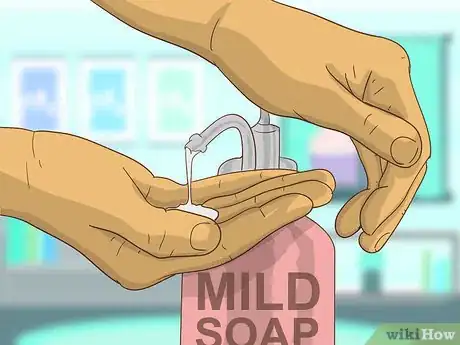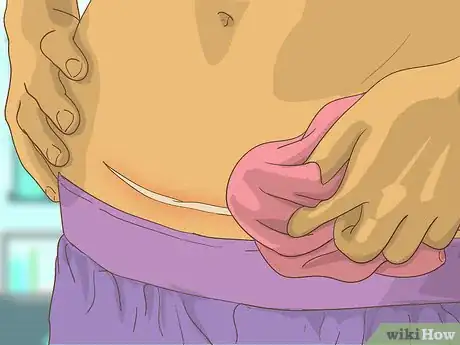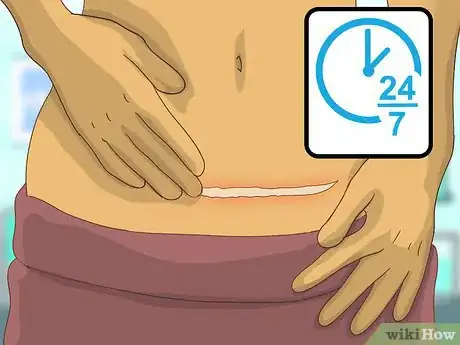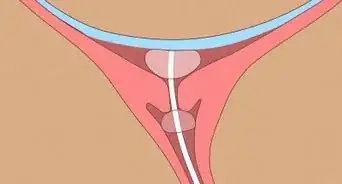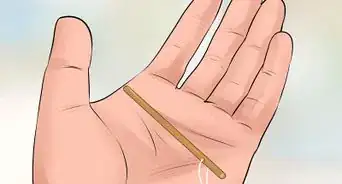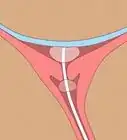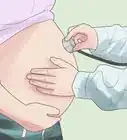This article was co-authored by Jennifer Butt, MD. Jennifer Butt, MD, is a board certified Obstetrician and Gynecologist operating her private practice, Upper East Side OB/GYN, in New York City, New York. She is affiliated with Lenox Hill Hospital. She earned a BA in Biological Studies from Rutgers University and an MD from Rutgers – Robert Wood Johnson Medical School. She then completed her residency in obstetrics and gynecology at Robert Wood Johnson University Hospital. Dr. Butt is board certified by the American Board of Obstetrics and Gynecology. She is a Fellow of the American College of Obstetricians and Gynecologists and a member of the American Medical Association.
This article has been viewed 46,540 times.
The birth of a new baby is very exciting and a lot of your time in the coming weeks and months will be devoted to caring for your little one. That being said, it is very important that new moms look after themselves as well, especially if your delivery included a C section. A C section is a major abdominal surgery and as a result it is important that you allow for a proper rest and recovery period. In order to care for a C section scar you should make sure that you take all of the necessary steps to heal the incision, clean the area around the scar, and monitor the scar. If you notice any signs of infection, you should talk to your doctor immediately.
Steps
Healing Your C Section Scar
-
1Listen to and follow your doctors instructions. Following your C section the doctor will likely give you a list of instructions on how to properly care for the incision scar. It is very important that you listen to your doctor and follow all of the instructions carefully. You don't want to end up back in the hospital dealing with an infection that could have been avoided.
-
2Cover the scar with a bandage. For the first twenty fours after your C section, your scar will be covered with a sterile bandage to reduce the chance of an infection. Your doctor will put on the bandage immediately following the procedure. These bandages will then be removed by your doctor or a nurse about 24 hours after the surgery.[1]Advertisement
-
3Take anti-inflammatory medication. Immediately following the procedure you will be given anti-inflammatory and pain medications to help reduce the swelling and pain caused by the surgery. These medications do not impact your ability to breastfeed and should be taken to help with your recovery. Make sure that your follow the directions carefully.[2]
- Some hospital staff may encourage women to hold an ice pack to the incision area for the first day to help reduce swelling.
-
4Stay in bed for 12-18 hours after the surgery. You will need to stay in bed for anywhere from 12 to 18 hours following the surgery. During this time, you will be hooked up to a catheter so you will not need to get up to go to the washroom. This rest time is necessary to allow your body to recover. Once the catheter has been removed, you should stand up and try walking around. This can begin to promote healing in your scar because it will help increase your blood circulation.[3]
-
5Have any staples removed before leaving the hospital. Prior to being discharged from the hospital, which will usually be about four days after delivery, your doctor will remove the staples from the incision. If your doctor used stitches instead of staples they will fall out on their own and do not need to be removed.[4]
-
6Expose the incision to air. Once the bandages have been removed, it is important that you expose your incision to the air. This will help promote healing. This does not mean that you have to walk around all day in a state of undress. Instead, avoid wearing tight clothes so that air can reach the scar.[5]
-
7Do not lift heavy objects. For the first few weeks after the surgery you should avoid lifting heavy objects. It is recommended that you not lift anything that is heavier than your newborn baby. This is so that you do not irritate your incision or cause tearing from over exertion. Hold off on any rigorous physical activity for at least 4-6 weeks to allow the scar to heal.[6]EXPERT TIPJennifer Butt, MD, is a board certified Obstetrician and Gynecologist operating her private practice, Upper East Side OB/GYN, in New York City, New York. She is affiliated with Lenox Hill Hospital. She earned a BA in Biological Studies from Rutgers University and an MD from Rutgers – Robert Wood Johnson Medical School. She then completed her residency in obstetrics and gynecology at Robert Wood Johnson University Hospital. Dr. Butt is board certified by the American Board of Obstetrics and Gynecology. She is a Fellow of the American College of Obstetricians and Gynecologists and a member of the American Medical Association.Board Certified Obstetrician & Gynecologist

 Jennifer Butt, MD
Jennifer Butt, MD
Board Certified Obstetrician & GynecologistOur Expert Agrees: In the first two weeks after your C-section, keep the incision clean and dry, avoid strenuous exercise, and don't lift anything heavier than 10 pounds. However, it's fine if you want to get up and walk around. In fact, I encourage my patients to be up and walking either the same day or the day after they have their baby.
-
8Ask your doctor about applying creams to the incision. Some doctors recommend applying anti-bacterial ointments to the scar tissue to help with healing. Other doctors believe that the best way to heal the incision is to avoid putting anything on the wound. Ask your doctor what is best for your particular incision.[7]
- About 6 weeks after the surgery you can begin to moisturize the area with creams.
Cleaning the Scar
-
1Avoid taking a bath. Immediately following the C section, you should avoid fully submerging the scar in water. This means you should not take a bath or go swimming. Ask your doctor how long you should wait before taking a shower.[8]
-
2Wash with a mild soap. You can still take a shower and clean the scar by allowing mild soapy water to wash over the incision area. Do not scrub the area. This could cause irritation and may lead to tearing.[9]
- Once the incision starts to heal, usually after a few weeks, you can resume your regular cleaning routine.
-
3Dry the area after showering. Once you have finished taking a shower, you should gently pat dry the area around the scar. You do not want to rub it to aggressively because this may cause irritation.[10]
Monitoring Your Incision Scar
-
1Check the scar daily. You should get in the habit of checking the incision area daily. Make sure that the incision does not separate. If you notice any bleeding or if the incision has a green or pus-coloured discharge, you should see your doctor immediately.[11]
- This could signal that your scar has developed an infection.
-
2Feel the scar. When you leave the hospital your incision will feel soft to the touch, but over the next few days you may begin to notice that if feels hard. This is completely normal and is called the healing ridge.[12]
-
3Monitor your scar for the first year. Your scar may appear slightly darker approximately one month after delivery. This is normal and the colour will begin to fade. At some point, approximately 6 months to a year after the procedure, your scar will stop changing.
- Typically incision scars are small and not noticeable.
Expert Q&A
-
QuestionHow do you clear up scars?
 Lydia Shedlofsky, DODr. Lydia Shedlofsky is a Resident Dermatologist who joined Affiliated Dermatology in July of 2019 after completing a traditional rotating internship at Larkin Community Hospital in Miami, Florida. She earned a Bachelor of Science in Biology at Guilford College in Greensboro, North Carolina. After graduation, she moved to Beira, Mozambique, and worked as a research assistant and intern at a free clinic. She completed a Post-Baccalaureate program and subsequently earned a Master's Degree in Medical Education and a Doctorate of Osteopathic Medicine (DO) from the Lake Erie College of Osteopathic Medicine.
Lydia Shedlofsky, DODr. Lydia Shedlofsky is a Resident Dermatologist who joined Affiliated Dermatology in July of 2019 after completing a traditional rotating internship at Larkin Community Hospital in Miami, Florida. She earned a Bachelor of Science in Biology at Guilford College in Greensboro, North Carolina. After graduation, she moved to Beira, Mozambique, and worked as a research assistant and intern at a free clinic. She completed a Post-Baccalaureate program and subsequently earned a Master's Degree in Medical Education and a Doctorate of Osteopathic Medicine (DO) from the Lake Erie College of Osteopathic Medicine.
Dermatologist Silicone can help reduce the appearance of scars over time. Use this topically with sunscreen each day to assist with healing. Microneedling is another possible option.
Silicone can help reduce the appearance of scars over time. Use this topically with sunscreen each day to assist with healing. Microneedling is another possible option.
Warnings
- See your doctor immediately if you experience a fever higher than 101 degrees, the incision separates, or you experience excessive bleeding (more than 1-2 pads/hour). This could indicate that you have an infection.⧼thumbs_response⧽
References
- ↑ http://www.babycenter.com/2_c-section-recovery-wound-care_10314058.bc
- ↑ http://www.babycenter.com/2_c-section-recovery-wound-care_10314058.bc
- ↑ http://www.babycenter.com/2_c-section-recovery-wound-care_10314058.bc
- ↑ http://www.parents.com/pregnancy/giving-birth/cesarean/c-section-scar-care/
- ↑ http://www.whattoexpect.com/pregnancy/c-section-scars
- ↑ http://www.whattoexpect.com/pregnancy/c-section-scars
- ↑ http://www.whattoexpect.com/pregnancy/c-section-scars
- ↑ http://www.parents.com/pregnancy/giving-birth/cesarean/c-section-scar-care/
- ↑ https://www.thebump.com/a/care-recovery-after-c-section
About This Article
If the delivery of your baby involved a C section, look after your scar so it can heal quickly. For the first 24 hours, keep it covered with a sterile bandage to reduce the risk of infection. You’ll also want to stay in bed for the first 12 to 18 hours to let the site begin to heal, but after that, it’s important to stand up and try to walk around to increase circulation. Once the bandages are removed, expose your incision to air by avoiding tight clothing. When your doctor gives you the go-ahead, clean the area with mild soapy water, but avoid scrubbing the area, which could cause irritation. Check your scar daily to make sure there’s no bleeding or discharge, which could indicate an infection. To learn how to monitor your C-section scar for the first year after surgery, keep reading!









